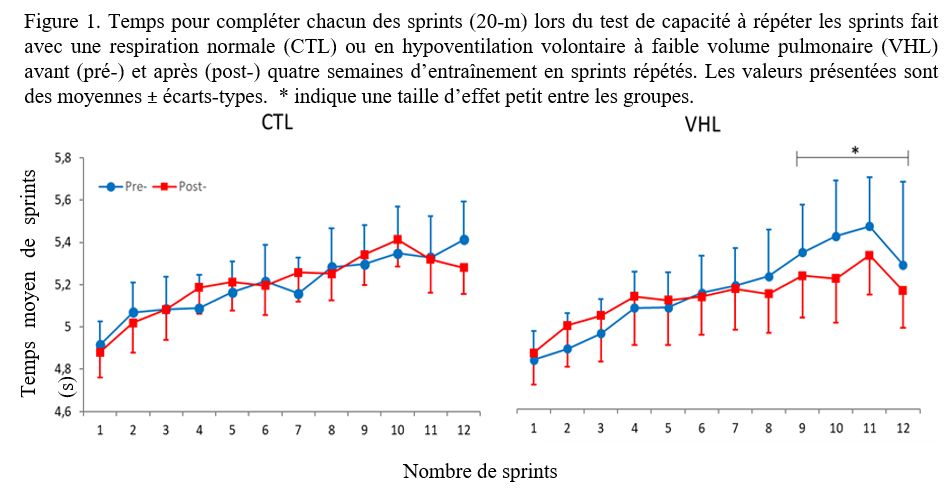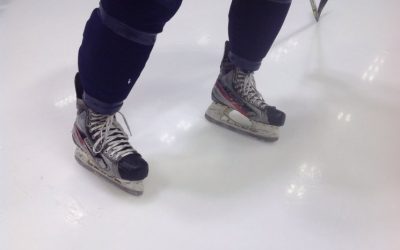The impact of voluntary hypoventilation on the ability to repeat sprints
In team and racquet sports, athletes have to perform a varied range of high or maximum intensity efforts, separated by less intense periods of a few seconds to a few minutes to allow the athlete to recover somewhat. To improve players’ physical condition and delay the onset of neuromuscular fatigue, training programs aim to improve, among other things,repeated-sprints ability (RSA). RSA is now well established as a critical determinant of performance in team sports and is influenced by a variety of physiological factors such as depletion of energy substrates, accumulation of metabolic by-products, changes in muscle membrane excitability and altered muscle recruitment strategies (1, 2). Studies have shown that RSA can be improved by training repeated sprints(RS), as well as other physical qualities such as aerobic capacity, sprint speed and jump height (3). In order to increase the stress imposed on athletes, and to expect higher gains, researchers have added hypoxic stress (i.e. an oxygen-depleted environment) to RS training(repeated-sprint in hypoxia, RSH). The groups trained under hypoxic conditions improved more markedly than the control group, and these adaptations are thought to be due to a greater contribution from the aerobic pathway, increasing VO2max, and better muscle reoxygenation, enabling more rapid resynthesis of energy substrates (4, 5). However, the organization of a training camp at altitude and/or the use of hypoxic apparatus requires a great deal of logistics and equipment, which may limit the feasibility and popularity of this training modality, particularly for team sports athletes. To get around this problem, nothing is simpler than to voluntarily and momentarily stop breathing to create hypoxemia. This modality is known as voluntary hypoventilation (VHL) and democratizes access to RSH training.
How to add voluntary hypoventilation to training?
Briefly, the VHL modality consists of holding the breath at a low lung volume during repeated short sprints at maximum intensity. Immediately before the sprint, the athlete should exhale normally (to residual functional capacity), then hold his breath and run as fast as possible for the duration of the sprint. Directly after sprinting, a second exhalation is necessary to evacuate theCO2 that has accumulated in the lungs during the sprint (6,7). Before incorporating VHL into training, athletes should familiarize themselves with the technique by gradually increasing sprint intensity during respiratory restriction. Coaches must pay close attention to the breathing pattern and frequently question the athlete about the difficulty of performing the task. Once familiar with the technique, it can be integrated into SR sessions by performing, for example, 3 sets of 8 sprints of 6-s at maximum intensity for 24-s of passive recovery between sprints. Sprinting can be done in a variety of ways, either on a bike or running in a straight line, or including changes of direction to suit the demands of the sport (8).
The relevance of voluntary hypoventilation
Several studies report an improvement in RSA following repeated sprint training combined with hypoventilation. An increase in the number of sprints before exhaustion increased from 26 to 58% in swimmers and rugby players (9, 10) and the performance deterioration score decreased from 23 to 30% in cyclists (11,12). More recently, we measured a significant reduction of almost 25% in the performance deterioration score in college basketball players training in repeated sprints including specific changes of direction (8). In this way, the VHL technique has a practical impact on athletes in team sports, giving them better sprint endurance. Fatigue is therefore less of an issue, with the accumulation of maximum effort allowing you to maintain better technique and greater lucidity. This is particularly interesting at the end of the game, when the team’s success is at stake.

The main aim of our research project was to investigate the physical adaptations underlying performance gains. To this end, during the RSA tests, measurements of muscle oxygenation, muscle electrical activity and blood analysis were taken, while performance was measured using SciencePerfo sensors.
The improvement is thought to be linked to greater anaerobic metabolism. In fact, training with restricted breathing induces hypoxemia, forcing the anaerobic pathways to supply energy to the muscles involved.
– The greater muscle reoxygenation observed during recovery periods may facilitate phosphocreatine resynthesis (13). The availability of phosphocreatine is very critical for RSA, and along with the aerobic pathway becomes the main sources of energy as sprints are repeated, while the contribution of anaerobic lactic glycolysis gradually fades (1, 2).
– Training with the VHL also led to better maintenance of initial muscle electrical activity values and stimulation frequencies concomitant with improved sprint endurance on subsequent repetitions. This could be explained by a more efficient muscular metabolic environment due to better reoxygenation. Inhibitory feedback to the central nervous system would thus be limited, and membrane excitability would be better maintained (14).
Message to remember
It’s clear that voluntary hypoventilation training improves the ability to repeat sprints. This performance determinant helps reduce the development of neuromuscular fatigue at the end of repeated sprints or a game. Consequently, the integration of this technique may be relevant for optimizing the development of physical qualities in team sports athletes. What’s more, this technique is effective in sport-specific contexts by adding changes of direction.
To find out more, here’s the link to the full article: https: //www.frontiersin.org/articles/10.3389/fspor.2020.00029/full
Written by : Julien Lapointe, Master’s student in Kinesiology.
Under the direction of François Billaut Ph.D,
References
- Billaut, F., & Bishop, D. (2009). Muscle Fatigue in Males and Females during Multiple-Sprint Exercise. Sports Med, 22.
- Girard, O., Mendez-Villanueva, A., & Bishop, D. (2011). Repeated-Sprint Ability-Part I. Sports Medicine, 41(8), 673-694. https://doi.org/10.2165/11590550-000000000-00000
- Taylor, J., Macpherson, T., Spears, I., & Weston, M. (2015). The Effects of Repeated-Sprint Training on Field-Based Fitness Measures: A Meta-Analysis of Controlled and Non-Controlled Trials. Sports Medicine, 45(6), 881-891. https://doi.org/10.1007/s40279-015-0324-9
- Brocherie, F., Girard, O., Faiss, R., & Millet, G. P. (2017). Effects of Repeated-Sprint Training in Hypoxia on Sea-Level Performance: A Meta-Analysis. Sports Medicine, 47(8), 1651-1660. https://doi.org/10.1007/s40279-017-0685-3
- Billaut, F., Gore, C. J., & Aughey, R. J. (2012). Enhancing Team-Sport Athlete Performance. Sports Medicine, 42(9), 751-767. https://doi.org/10.1007/BF03262293
- Woorons, X., Mollard, P., Pichon, A., Duvallet, A., Richalet, J.-P., & Lamberto, C. (2007). Prolonged expiration down to residual volume leads to severe arterial hypoxemia in athletes during submaximal exercise. Respiratory Physiology & Neurobiology, 158(1), 75-82. https://doi.org/10.1016/j.resp.2007.02.017
- Woorons, X., Bourdillon, N., Vandewalle, H., Lamberto, C., Mollard, P., Richalet, J.-P., & Pichon, A. (2010). Exercise with hypoventilation induces lower muscle oxygenation and higher blood lactate concentration: Role of hypoxia and hypercapnia. European Journal of Applied Physiology, 110(2), 367-377. https://doi.org/10.1007/s00421-010-1512-9
- Lapointe, J., Paradis-Deschênes, P., Woorons, X., Lemaître, F., & Billaut, F. (2020). Impact of Hypoventilation Training on Muscle Oxygenation, Myoelectrical Changes, Systemic [K+], and Repeated-Sprint Ability in Basketball Players. Frontiers in Sports and Active Living, 2. https://doi.org/10.3389/fspor.2020.00029
- Trincat, L., Woorons, X., & Millet, G. P. (2017). Repeated-Sprint Training in Hypoxia Induced by Voluntary Hypoventilation in Swimming. International Journal of Sports Physiology & Performance, 12(3), 329-335.
- Fornasier-Santos, C., Millet, G. P., & Woorons, X. (2018). Repeated-sprint training in hypoxia induced by voluntary hypoventilation improves running repeated-sprint ability in rugby players. European Journal of Sport Science, 18(4), 504-512. https://doi.org/10.1080/17461391.2018.1431312
- Woorons, X., Millet, G. P., & Mucci, P. (2019). Physiological adaptations to repeated sprint training in hypoxia induced by voluntary hypoventilation at low lung volume. European Journal of Applied Physiology, 119(9), 1959-1970. https://doi.org/10.1007/s00421-019-04184-9
- Woorons, X., Billaut, F., & Vandewalle, H. (2020). Transferable Benefits of Cycle Hypoventilation Training for Run-Based Performance in Team-Sport Athletes. International Journal of Sports Physiology and Performance, 1-6. https://doi.org/10.1123/ijspp.2019-0583
- McMahon, S., & Jenkins, D. (2002). Factors Affecting the Rate of Phosphocreatine Resynthesis Following Intense Exercise. Sports Medicine, 32(12), 761-784. https://doi.org/10.2165/00007256-200232120-00002
- Amann, M., & Dempsey, J. A. (2008). Locomotor muscle fatigue modifies central motor drive in healthy humans and imposes a limitation to exercise performance. The Journal of Physiology, 586(Pt 1), 161-173. https://doi.org/10.1113/jphysiol.2007.141838
Want to stay on top of new articles before they’re published?
Subscribe to our newsletter.
From the same author
Why is it easier to turn left?
Why is it easier to turn left? MAXIME Sports physiotherapist In a field hockey match, various skating techniques are used to counter the opponent. A technique of choice for quickly changing direction while maintaining good speed is the sharp turn. On the one hand,...

